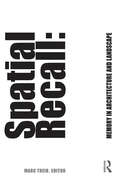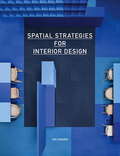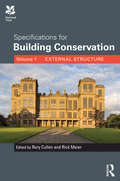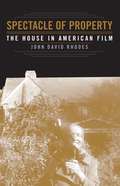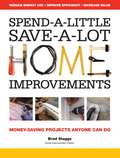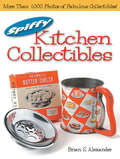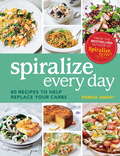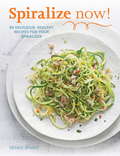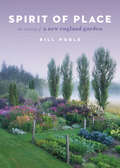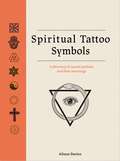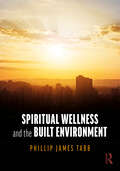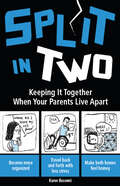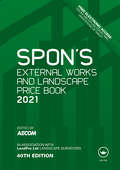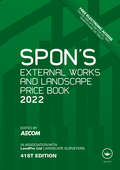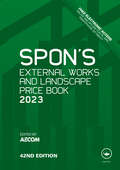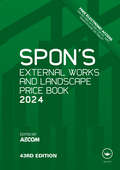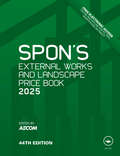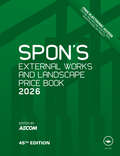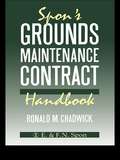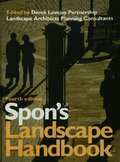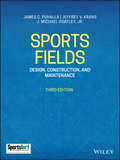- Table View
- List View
Spatial Recall: Memory in Architecture and Landscape
by Marc TreibArchitecture and designed landscapes serve as grand mnemonic devices that record and transmit vital aspects of culture and history. Spatial Recall casts a broad net over the concept of memory and gives a variety of perspectives from twelve internationally noted scholars, practicing designers, and artists such as Juhani Pallasmaa, Adriaan Geuze, Susan Schwartzenberg, Georges Descombes and Esther da Costa Meyer. Essays range from broad topics of message and audience to specific ones of landscape production. Beautifully illustrated, Spatial Recall is a comprehensive view of memory in the built environment, how we have read it in the past, and how we can create it in the future. Please note this is book is now printed digitally.
Spatial Strategies for Interior Design
by Ian HigginsThis inspirational and practical guide to organizing and planning interior spaces is packed with photographs, diagrams, models, case studies, and step-by-step instructions. It provides useful information on finding ways to start the design process, analyzing existing buildings, using planning diagrams, developing three-dimensional spatial compositions, designing in section, how to communicate your design ideas, and much more.
Spatial Strategies for Interior Design
by Ian HigginsThis inspirational and practical guide to organizing and planning interior spaces is packed with photographs, diagrams, models, case studies, and step-by-step instructions. It provides useful information on finding ways to start the design process, analyzing existing buildings, using planning diagrams, developing three-dimensional spatial compositions, designing in section, how to communicate your design ideas, and much more.
Specifications for Building Conservation: Volume 1: External Structure
by Rick Meier Rory CullenIn Specifications for Building Conservation, the National Trust draws on a range of case studies and specifications to provide a much needed guide to specification writing for building conservation. Although traditional building accounts for approximately a quarter of all buildings in the UK, the old skills and understanding required for their care and maintenance have been increasingly eroded over the last century. As the largest heritage charity in Europe, the National Trust has a first class reputation for high standards of conservation and care, and in this three volume set, the Trust brings together a remarkable pool of expertise to guide conservation professionals and students through the process of successful specification writing. This first book focusses on the materials used for the external fabric, detailing successful approaches employed by the National Trust at some of their most culturally significant sites. A range of studies have been carefully selected for their interest, diversity and practicality; showcasing projects from stonework repairs on the magnificent Grade I listed Hardwick Hall to the re-thatching of the traditional cottages of the Holnicote Estate. Complete with a practical Conservation Management Plan checklist, this book will enable practitioners to develop their skills, allowing them to make informed decisions when working on a range of project types. This is the first practical guide to specification writing for building conservation and the advice provided by the National Trust experts will be of interest to any practitioners and students involved in building conservation, both in the UK and beyond. Profits generated from the sale of this publication will go to the National Trust Building Apprenticeship Scheme. This provides placements for traditional skills at National Trust properties.
Spectacle of Property: The House in American Film
by John David RhodesMuch of our time at the movies is spent in other people&’s homes. Cinema is, after all, often about everyday life. Spectacle of Property is the first book to address the question of the ubiquitous conjuncture of the moving image and its domestic architecture. Arguing that in cinema we pay to occupy spaces we cannot occupy, John David Rhodes explores how the house in cinema both structures and criticizes fantasies of property and ownership.Rhodes tells the story of the ambivalent but powerful pleasure we take in looking at private property onscreen, analyzing the security and ease the house promises along with the horrible anxieties it produces. He begins by laying out a theory of film spectatorship that proposes the concept of the &“spectator-tenant,&” with reference to films such as Gone with the Wind and The Magnificent Ambersons. The book continues with three chapters that are each occupied with a different architectural style and the films that make use of it: the bungalow, the modernist house, and the shingle style house. Rhodes considers a variety of canonical films rarely analyzed side by side, such as Psycho in relation to Grey Gardens and Meet Me in St. Louis. Among the other films discussed are Meshes of the Afternoon, Mildred Pierce, A Star Is Born, Killer of Sheep, and A Single Man.Bringing together film history, film theory, and architectural history as no book has to date, Spectacle of Property marks a new milestone in examining cinema&’s relationship to realism while leaving us vastly more informed about, if less at home inside, the houses we occupy at the movies.
Spectacular Walls!
by Jeannine DostalMake you home sparkle with originality using a little imagination and these easy techniquesYour home will be like none other when you add texture and embellishments to your walls. Specialized walls are the latest decorating trend, as seen on many home decorating shows. Now you can make your own walls look "spectacular" by following the simple instructions in Spectacular Walls. Most techniques can be done in 5 to 6 steps, following Jeannine Dostal's quick and easy directions.The book features:38 different wall finishes, which can be used in any room in your home.Easy-to-find materials that can be purchased inexpensively at any craft or hardware store.Dozens of tips throughout the book to help you achieve amazing results.Detailed step-by-step photos and close-up shots of the finished techniques to make embellishing your walls a snap!Your home will truly be "spectacular" when you use these fun and easy techniques to create one-of-a-kind rooms. Textured walls are the perfect accessory for every home. From fun to sophisticated, there's a finish for everyone. So pick up a paintbrush and start creating your won "spectacular walls"!
Spend-A-Little Save-A-Lot Home Improvements: Money-saving Projects Anyone Can Do
by Brad StaggsSpend-A-Little, Save-A-Lot Home Improvements will help anyone save money by making their homes energy efficient and safe. Many of the projects have "green" benefits that will help reduce energy consumption. Step-by-step photos and instructions will show homeowners how to complete home improvement projects. Whether prepping a house for sale, or upgrading a "keeper", the projects in this book will prove valuable, in a real sense.
Spiffy Kitchen Collectibles
by Brian AlexanderFun in the Fifties KitchenThat was the marketing strategy of the companies producing the wide range of gadgets and products designed to make life in the kitchen much easier and a whole lot more colorful. Take this period tour full of '50s flair from teleservers for snacking to barbeque equipment for family gatherings to appetizer sets for entertaining.Coverage Includes: • Clocks, salt and pepper shakers, Lustro-Ware, cookie cutters and cake molds • Collectible advertising premiums from products such as Aunt Jermima and Planters • 1,000 photos and prices • Manufacturers such as: Ekco, Foley, Plas-tex, Rubbermaid and Rival
Spiralize Everyday: 80 recipes to help replace your carbs
by Denise SmartSpiralize, mash and rice your fruit and vegetables for a lighter alternative to pasta, bread, rice and more. Replace egg noodles with spiralized sweet potato, make a pizza with a courgette base, or snack on beetroot crisps instead of potato ones! With recipes for breakfasts, salads, light bites, mains, preserves, baking and desserts, Spiralize Everyday is the ultimate companion for all your spiralizing needs. It features 80 simple, tasty, low-carb recipes, including:Apple and blueberry buckwheat pancakesMoroccan beetroot tabbouleh with pomegranate and chickenMiso baked cod with daikon noodles and greensKimchiEasy pear, apple and ginger jamApple, cheese and walnut breadBeetroot and chocolate browniesSimple and fun, these recipes allow you to enjoy all your favourite treats in a new, healthier guise.
Spiralize Now: 80 Delicious, Healthy Recipes for your Spiralizer
by Denise SmartThe must-have gadget for 2015, in minutes the spiralizer creates spaghetti, ribbons and spirals from your favourite vegetables. From courgetti (courgette spaghetti) to cunoodles (cucumber noodles), it is now easier than ever to create healthy twists to your favourite meals. Perfect for the health-conscious, these vegetables can become the star of your dish, replacing heavier ingredients such as pasta and rice, so that you can enjoy your meal while eating fewer calories and cutting back on refined carbohydrates.With recipes ranging from Thai beef salad and Crispy spiralized potato fries to Courgette and lemon drizzle cake and Apple tarte tatin, The Complete Spiralizer Cookbook will open your eyes to the true versatility of the spiralizer.
Spirit of Place: The Making of a New England Garden
by Bill Noble&“Delve into this beautiful book. You&’ll come away sharing his passion for the beauty that gardens bring into our lives.&” —Sigourney Weaver, environmentalist, actor, trustee of New York Botanical Garden How does an individual garden relate to the larger landscape? How does it connect to the natural and cultural environment? Does it evoke a sense of place? In Spirit of Place, Bill Noble—a lifelong gardener, and the former director of preservation for the Garden Conservancy—helps gardeners answer these questions by sharing how they influenced the creation of his garden in Vermont. Throughout, Noble reveals that a garden is never created in a vacuum but is rather the outcome of an individual&’s personal vision combined with historical and cultural forces. Sumptuously illustrated, this thoughtful look at the process of garden-making shares insights gleaned over a long career that will inspire you to create a garden rich in context, personal vision, and spirit.
Spiritual Tattoo Symbols: A Directory of Sacred Symbols and their Meanings
by Alison DaviesAn inspirational sourcebook of over 500 spiritual designs. Body art has been a means of self-expression throughout the world for thousands of years, encompassing emblems of protection or connection, personal empowerment, transformation and enlightenment.From minimalist line work to flora, fauna and mythology, this book offers a huge range of tattoo designs - and explains the meaning, history and cultural provenance of each symbol.Meticulously researched and beautifully illustrated, this is an essential reference for tattoo artists and anyone seeking a design with profound meaning.
Spiritual Tattoo Symbols: A Directory of Sacred Symbols and their Meanings
by Alison DaviesAn inspirational sourcebook of over 500 spiritual designs. Body art has been a means of self-expression throughout the world for thousands of years, encompassing emblems of protection or connection, personal empowerment, transformation and enlightenment.From minimalist line work to flora, fauna and mythology, this book offers a huge range of tattoo designs - and explains the meaning, history and cultural provenance of each symbol.Meticulously researched and beautifully illustrated, this is an essential reference for tattoo artists and anyone seeking a design with profound meaning.
Spiritual Wellness and the Built Environment
by Phillip James TabbImagine a world where buildings and cities actively nurture our well-being, not just physically but spiritually. There is a growing awareness of the need for a more inclusive and comprehensive approach to wellness strategies in everyday life. This book explores spiritual wellness as a foundational attribute of urban planning and design with the hope of influencing a more flourishing trajectory of development with the built environment. Chapters reflect the beginning of this evolving movement in home and community design that tackles our uniquely modern problems of sedentary lives, unhealthy diets, stress, social isolation, pollution, nature deprivation, and inaccessibility to spiritually nurturing places. The attributes of spiritual wellness are presented as defining characteristics informing design strategies. These specific planning and design strategies are presented through case studies from around the globe that highlight the importance of spiritual wellness considerations at all scales of the built environment, from rooms to cities. This book is essential to help architects, planners, designers, engineers, healthcare providers, project stakeholders, and graduate students embrace and implement a successful wellness design approach.
Split in Two: Keeping it Together When Your Parents Live Apart
by Karen BuscemiTackling an under-addressed but common difficulty for teens in split families, Split in Two is a valuable resource guide to help teens feel less crazed and confused, and more self-confident. Complete with: - Personal advice from teens who have lived or are living in two households - Tips on goal-setting and planning skills - Comic-book-style illustrations that give the book an edgy, modern, graphic novel feel
Spon's External Works and Landscape Price Book 2021 (Spon's Price Books)
by AecomNow in its 40th edition, Spon's External Works and Landscape Price Book 2021 offers the only comprehensive source of information for detailed external works and landscape costs. It covers all the items to be found in hard and soft landscape contracts, and forms an indispensable reference book for quantity surveyors, landscape architects, contractors and local authority managers – essential for compiling estimates, specifications, bills of quantities and works schedules – no matter what the size of the project being undertaken. Use the access code inside the front cover of the book to get set up with an ebook of this 2021 edition on the VitalSource® Bookshelf platform, available for access and use until the end of December 2021. This NRM edition provides a revised and updated street furniture section. It also includes several new items: Kinley systems – Metal edgings and systems for landscapes and podiums New cost evaluations of water features Stainless steel landscape channel drainage All the standard features that you expect from SPON'S EXTERNAL WORKS AND LANDSCAPE PRICE BOOK remain: • material and measured work prices covering contract items from preliminaries and site clearance and encompassing the core external works activities with full breakdowns into labour, materials and other components • detailed guidance on wage rates, landscape consultants’ fee scales • an extensive Approximate Estimates section for rapid spot estimating • updates, free of charge, twice a year – see inside for registration details. Updates are available online at www.pricebooks.co.uk
Spon's External Works and Landscape Price Book 2022 (Spon's Price Books)
by AecomNow in its 41st edition, Spon's External Works and Landscape Price Book 2022 offers the only comprehensive source of information for detailed external works and landscape costs. It covers all the items to be found in hard and soft landscape contracts, and forms an indispensable reference book for quantity surveyors, landscape architects, contractors and local authority managers – essential for compiling estimates, specifications, bills of quantities and works schedules – no matter what the size of the project being undertaken. The 2022 edition includes new stainless-steel products including: ventilation grilles; handrails; LED handrails; in ground power units; stainless steel bollards; stainless steel warning strips and studs and access covers. Also, an extended range of inspection chambers, new podium specialist soils and a new formwork system, as well as two new Cost Models, one for podiums and another for landscape maintenance. All the standard features that you expect from SPON'S EXTERNAL WORKS AND LANDSCAPE PRICE BOOK remain: • material and measured work prices covering contract items from preliminaries and site clearance and encompassing the core external works activities with full breakdowns into labour, materials and other components • detailed guidance on wage rates, landscape consultants’ fee scales • an extensive Approximate Estimates section for rapid spot estimating • updates, free of charge, twice a year – see inside for registration details. Updates are available online at www.pricebooks.co.uk Use the access code inside the front cover of the book to get set up with an ebook of this 2022 edition on the VitalSource® Bookshelf platform, available for access and use until the end of December 2022.
Spon's External Works and Landscape Price Book 2023 (Spon's Price Books)
by AecomNow in its 42nd edition, Spon's External Works and Landscape Price Book 2023 offers the only comprehensive source of information for detailed external works and landscape costs. It covers all the items to be found in hard and soft landscape contracts, and forms an indispensable reference book for quantity surveyors, landscape architects, contractors and local authority managers – essential for compiling estimates, specifications, bills of quantities and works schedules – no matter what the size of the project being undertaken. The 2023 edition includes: updated key resources to obtain the latest market pricing and align with the latest supply material specifications and/or quantities guidance on land remediation, tax relief, capital allowances and aggregates levies revised rates in line with the latest market forecasts and indices, which include the impacts of Brexit, the pandemic, Ukraine supply chain disruption and the energy crisis All the standard features that you expect from SPON'S EXTERNAL WORKS AND LANDSCAPE PRICE BOOK remain: • material and measured work prices covering contract items from preliminaries and site clearance and encompassing the core external works activities with full breakdowns into labour, materials and other components • detailed guidance on wage rates, landscape consultants’ fee scales • an extensive Approximate Estimates section for rapid spot estimating • updates, free of charge, twice a year – see inside for registration details. Updates are available online at www.pricebooks.co.uk Use the access code inside the front cover of the book to get set up with an ebook of this 2023 edition on the VitalSource® Bookshelf platform, available for access and use until the end of December 2023.
Spon's External Works and Landscape Price Book 2024 (Spon's Price Books)
Compiled by AECOM, the 2024 edition has been updated with the latest pricing information to help you manage your projects over the next 12 months through this challenging period of high inflation and financial uncertainty. It covers all the items to be found in hard and soft landscape contracts, and forms an indispensable reference book for quantity surveyors, landscape architects, contractors and local authority managers – essential for compiling estimates, specifications, bills of quantities and works schedules – no matter what the size of the project being undertaken. All prices have been updated via a short-term inflationary forecast combined with AECOM’s market intelligence to ensure you have the most accurate cost data available. Activity descriptions and build ups have been updated to reflect changes to standard specifications, Building Regulation changes, emerging practices, and changing outputs All the standard features you have come to expect from SPON'S are also included: Material and measured work prices covering contract items from preliminaries and site clearance and encompassing the core external works activities Full breakdowns into labour, materials and other components Detailed guidance on wage rates, landscape consultants’ fee scales An extensive Approximate Estimates section for rapid spot estimating Included within the inside front cover of every book is a VitalSource eBook redemption code giving one user access to the content digitally until the end of December 2024.
Spon's External Works and Landscape Price Book 2025 (Spon's Price Books)
Now in its 44th edition, Spon's External Works and Landscape Price Book 2025 offers the only comprehensive source of information for detailed external works and landscape costs. It covers all the items to be found in hard and soft landscape contracts, and forms an indispensable reference book for quantity surveyors, landscape architects, contractors and local authority managers – essential for compiling estimates, specifications, bills of quantities and works schedules – no matter what the size of the project being undertaken.All the standard features that you expect from SPON'S EXTERNAL WORKS AND LANDSCAPE PRICE BOOK remain:• material and measured work prices covering contract items from preliminaries and site clearance and encompassing the core external works activities with full breakdowns into labour, materials and other components• detailed guidance on wage rates, landscape consultants’ fee scales• an extensive Approximate Estimates section for rapid spot estimatingUse the access code inside the front cover of the book to get set up with an ebook of this edition on the VitalSource® Bookshelf platform, available for access and use until the end of December 2025.
Spon's External Works and Landscape Price Book 2026 (Spon's Price Books)
Now in its 45th edition, Spon's External Works and Landscape Price Book 2026 offers the only comprehensive source of information for detailed external works and landscape costs. It covers all the items to be found in hard and soft landscape contracts, and forms an indispensable reference book for quantity surveyors, landscape architects, contractors and local authority managers – essential for compiling estimates, specifications, bills of quantities and works schedules – no matter what the size of the project being undertaken.All the standard features that you expect from SPON'S EXTERNAL WORKS AND LANDSCAPE PRICE BOOK remain:• material and measured work prices covering contract items from preliminaries and site clearance and encompassing the core external works activities with full breakdowns into labour, materials and other components• detailed guidance on wage rates, landscape consultants’ fee scales• an extensive Approximate Estimates section for rapid spot estimatingUse the access code inside the front cover of the book to get set up with an ebook of this edition on the VitalSource® Bookshelf platform, available for access and use until the end of December 2026.
Spon's Grounds Maintenance Contract Handbook
by Mr R Chadwick R.M. ChadwickAimed at those at the sharp end of contract grounds maintenance, this book will provide guidance for anyone unfamiliar with the process of contracting work out. Written in a clear and readable style and full of practical details it will be particularly valuable to local authorities who, from 1990 will be thrown into contractual maintenance and competitive tendering for the first time.
Spon's Landscape Contract Handbook: A guide to good practice and procedures in the management of lump sum landscape contracts
by Hugh Clamp H. ClampThis indispensable manual for landscape work covers the documentation and management of landscape contracts. It is written for all those involved in the landscape industry.
Spon's Landscape Handbook
by Derek Lovejoy PartnershipThere have been such great changes in legislation, official guidance, the British Standards and the techniques used in landscape and external works since the third edition was written ten years ago that the Handbook has been totally rewritten for this edition.This new edition of the Handbook provides a guide to planning and landscape law, a review of computer-aided design techniques for landscape designers, together with guidance on data to be collected during first site visits. The opportunity has been taken to change the format of the work sections to comply with SMM7 to make it easier to find specific items and to read in conjunction with the current edition of Spon's Landscape and External Works Price Book. The SMM7 sections are now divided into four parts - General Guidance, British Standards, Data and Outline Specification. Diagrams, typical drawings and photographs illustrate each section. The useful bibliography has been updated and revised.
Sports Fields: Design, Construction, and Maintenance
by James C. Puhalla Jeffrey V. Krans J. Michael Goatley Jr.THE UPDATED, AUTHORITATIVE GUIDE TO SPORTS FIELD MANAGEMENT THAT INCLUDES THE LATEST DEVELOPMENTS IN, AND ON, THE FIELD The updated Third Edition of Sports Fields: Design, Construction, and Maintenance is a comprehensive reference for professionals who are responsible for the design, construction, renovation, and maintenance of athletic facilities. This book contains illustrative examples of specific design elements of the most popular sports facilities. This Third Edition contains new chapters on safety, public relations, and professionalism for future sports field managers, as well as fresh drawings and photos that highlight innovative field layout, grading, irrigation, and drainage. All-new case studies review best practices and techniques for sports fields ranging from youth and high school fields to fields that are designed for professional athletes. This text is also an ideal resource for anyone studying for Sports Field Manager Certification (offered by STMA). Features new case studies that include design and management best practices for all levels and types of sports facilities Offers new chapters on safety, public relations, and professionalism for future sports field managers Includes new illustrations and photos of innovative field layout, grading, irrigation, and drainage Contains the most recent information on sand-based field systems and synthetic turf Presents discussions of a range of fields including baseball, softball, football, soccer, lacrosse, field hockey, tennis, and track and field Sports Fields: Design, Construction, and Maintenance, Third Edition is a blueprint for field managers, designers, and builders for successful sports field projects.
